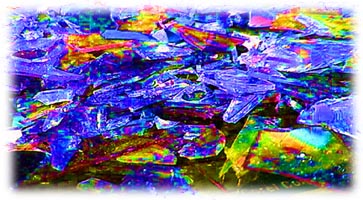

Epsilon Omega City, 2025 AD. Photographer: Jörgen Städje
But where's the limit? Manufacturers try to outspin each other all the time by selling CD-ROM drives with higher and higher spin ratios. Spin ratios of 2x, 4x, 8x, 16x, 32x, 56x and 64x come in a never ending stream. The CD is forced to rotate faster and faster. At what speed will a CD blow up, and can you do something to prevent it from exploding?
I decided to investigate all facts of the case:
The case was scientifically investigated at the electronics labs of Atlas Copco AB in Tyresö, outside Stockholm. We used a motor capable of 30,000 revolutions per minute, and a specially machined hub to keep the CD record as vibration-free as possible.
The Audio CD Standard was set sometime back in the 70's. Then, it was decided that the record should rotate with different speeds, depending on where on the record the data was read, to get a constant data transfer rate. The method is named CLV (Constant Linear Velocity), or constant transfer rate. The transfer rate of an audio CD is a mere 176 kB/s, and to reach this rate the record only has to spin with 530 rpm when reading the innermost track, and 200 rpm for the outer track.
To be able to publish ever increasing spin ratios, many manufacturers have resorted to CAV (Constant Angular Velocity), a method whereby the record is not rotated faster when reading inner tracks. Thus they can specify impressive spin ratios for outer tracks and sell more, but in reality the spin ratio for the inner tracks is only 37.7% of this value.
A 64x drive using CLV would have to rotate the disc with 33,920 rpm when reading an inner track, exposing the hub of the disk to a tangential force of some 45 N/mm2. A point on the periphery of the disc will be moving with 213 metres per second, slightly more than half the speed of sound. Can the disc take that?
The answer is no. A powerful no.
At about 52x, i.e. 27,500 rpm, most manufacturer's CDs blew up in a rain of plastic particles, leaving their marks on the premises. The result was a pile of shimmering plastic chips.
The CD-ROM which was to be strength tested was mounted inside damage-resistant testing equipment in a soundproofed room, complete with a shatterproof observation window.
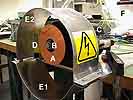 The device under test A, was mounted to the hub B
with a stud and a number of centering and holding washers in plastic material. The hub B was machined into the
shaft of motor C, a three-phase motor for industrial washing machines. D was a sensor, sensing rotational speed
and E1 and E2 the lower and upper shrapnel protectors, respectively, manufactured from 1.0 mm aluminium. F was
the heavily armoured wall of the testing chamber, provided with a shatterproof observation window made of an amorphous
silicon compound.
The device under test A, was mounted to the hub B
with a stud and a number of centering and holding washers in plastic material. The hub B was machined into the
shaft of motor C, a three-phase motor for industrial washing machines. D was a sensor, sensing rotational speed
and E1 and E2 the lower and upper shrapnel protectors, respectively, manufactured from 1.0 mm aluminium. F was
the heavily armoured wall of the testing chamber, provided with a shatterproof observation window made of an amorphous
silicon compound.
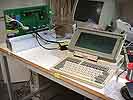 As you may see, the electronic equipment
is extensive and very advanced. To the far left is a digital-analogue three-phase generator (a drive) able to deliver
10 Amps and 600 Volts with controllable frequency up to 1000 Hz, to run the connected motor up to 30,000 rpm. The
drive is controlled by a portable PC, an advanced model when it was bought in 1985, today specially adapted as
control terminal for our explosive experiments. Behind this you may see, carefully arranged, lots of other advanced
equipment, such as an advanced roll of tape, a high tech plastic container, some superconducting cables and to
the far right, an advanced roll of soldering tin (red).
As you may see, the electronic equipment
is extensive and very advanced. To the far left is a digital-analogue three-phase generator (a drive) able to deliver
10 Amps and 600 Volts with controllable frequency up to 1000 Hz, to run the connected motor up to 30,000 rpm. The
drive is controlled by a portable PC, an advanced model when it was bought in 1985, today specially adapted as
control terminal for our explosive experiments. Behind this you may see, carefully arranged, lots of other advanced
equipment, such as an advanced roll of tape, a high tech plastic container, some superconducting cables and to
the far right, an advanced roll of soldering tin (red).
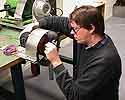 The technician Thord Nilson (Ye Olde Wizarde), under
maximum spiritual concentration and greatest possible silence, conducts manual balancing of one device under test.
The tool in his hand, a Borkhardt SMS4579-A is used for tightening the fastening attachment in the centre of the
hub (B in the picture above). The equipment in the background, the green cylinder, is a secret part of Atlas Copco's
research work, a so called Spluriser. Because of this, you should forget it immediately.
The technician Thord Nilson (Ye Olde Wizarde), under
maximum spiritual concentration and greatest possible silence, conducts manual balancing of one device under test.
The tool in his hand, a Borkhardt SMS4579-A is used for tightening the fastening attachment in the centre of the
hub (B in the picture above). The equipment in the background, the green cylinder, is a secret part of Atlas Copco's
research work, a so called Spluriser. Because of this, you should forget it immediately.
The test was conducted in such a manner that the DUT (Device Under Test) was mounted as vibration-free as possible in the test equipment, the personnel left the room, the room was hermetically sealed, protective clothing was donned, and we took up a safe position at the observation window.
The rotational speed was slowly increased from zero (ramping) towards 30,000 rpm and the operational parameters were recorded at the point of breaking.
The disc manufacturer, speed at destruction, power loss, temperature etc., were carefully recorded and became the basis of the “Table of Result”, in Appendix A.
This was repeated for all eleven DUTs. It is worth noting that we increased the speed manually in the beginning, but later changed and let the explosion-control electronics increase the speed (direct ramping). The latter resulted in a somewhat increased durability of the DUT, usually a few thousand rpms.
Also note that the whining of the motor, the vibrations in the walls and the roaring of the CD-ROM disc, not unlike the sound of a crashing jet aeroplane, was impressive, and of course drew great interest from the staff at neighbouring laboratories.
When the disc fractured, there was a sharp bang and the test chamber was filled with shimmering, glittering shrapnel, and our grins were big. We hurried in and mounted the next disc, to be able to shoot again as fast as possible.
At 30,000 rpm the periphery of the disc is subjected to over 1500 g, and the hub is subjected to a force of 35 N/mm2 on its inner side. It is this force that will ultimately break up the disc.
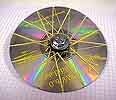
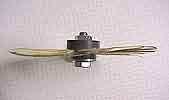 In our
efforts of reaching ever increasing speeds, we tried to reinforce a disc with Kevlar wires. The wire was wound
across the disc, as seen in the first picture. As Kevlar needs some pre-tensioning, the disc shows some warping
when resting, as seen in the second picture. The warping disappears at increased speeds, though.
In our
efforts of reaching ever increasing speeds, we tried to reinforce a disc with Kevlar wires. The wire was wound
across the disc, as seen in the first picture. As Kevlar needs some pre-tensioning, the disc shows some warping
when resting, as seen in the second picture. The warping disappears at increased speeds, though.
Kevlar is the strongest material in existence, many times stronger than unhardened steel and sewing thread. The wire we used, had an ultimate tensile strength of 80 N. As the wire was wound 5 times around the same point on the disc periphery, the wire bundle had a total ultimate tensile strength of 400 N (enough to hang a bicycle in).
It turned out our motor didn't have enough power to spin up the disc enough to explode it in one try, because the Kevlar wires consumed several hundred watts of motor power for aerobreaking.
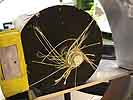 After an extended period of time (about
20 seconds) at close to 28,000 rpm, the disc blew up with a loud bang anyway, with the wires remaining on the hub,
as shown in the picture. It can be clearly seen that the wires remains pointing radially from the hub. The Kevlar
wires had been stretched radially and performed as intended. What made the disc explode, was the creepage of the
plastic material, i.e. its stretching over time, subjected to the high g forces.
After an extended period of time (about
20 seconds) at close to 28,000 rpm, the disc blew up with a loud bang anyway, with the wires remaining on the hub,
as shown in the picture. It can be clearly seen that the wires remains pointing radially from the hub. The Kevlar
wires had been stretched radially and performed as intended. What made the disc explode, was the creepage of the
plastic material, i.e. its stretching over time, subjected to the high g forces.
The result surpassed our wildest hopes, sorry: the result was scientifically convincing. The premises and the test equipment also became slightly modified during the testing.
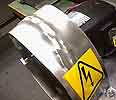 The CD fragments left the disc at
such high ejection speed that they deformed the shrapnel protectors, made out of 1.0 mm aluminium. The protectors
were dented, torn up, and knocked off their fastening bolts.
The CD fragments left the disc at
such high ejection speed that they deformed the shrapnel protectors, made out of 1.0 mm aluminium. The protectors
were dented, torn up, and knocked off their fastening bolts.
 One fragment has hit the
protector with such force, that the metal has been torn up in an 8 mm rift. It is not probable that the fragment
passed through the crack.
One fragment has hit the
protector with such force, that the metal has been torn up in an 8 mm rift. It is not probable that the fragment
passed through the crack.
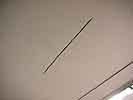 At a pre-test, performed without shrapnel protection,
long rifts were torn in the ceiling, as shown in the picture. The speed sensor also had its surface coating ripped
off.
At a pre-test, performed without shrapnel protection,
long rifts were torn in the ceiling, as shown in the picture. The speed sensor also had its surface coating ripped
off.
 Decontamination of the premises was time
consuming, and yet it was not possible to recover all the shrapnel. We did remove so much, that there is no longer
any great risk of damage to the environment or the climate. The picture shows the nice collection of plastic pieces
remaining after the tests.
Decontamination of the premises was time
consuming, and yet it was not possible to recover all the shrapnel. We did remove so much, that there is no longer
any great risk of damage to the environment or the climate. The picture shows the nice collection of plastic pieces
remaining after the tests.
 A close-up of the shrapnel, showing its enormous
diversity, and its interesting colour characteristics. The self-tapping screw visible in the middle left, BZX4x12,
galvanised steel, is not attributable to our experiment, but has to be ascribed to the extremely carefully, close
to exaggeration, carried out decontamination process.
A close-up of the shrapnel, showing its enormous
diversity, and its interesting colour characteristics. The self-tapping screw visible in the middle left, BZX4x12,
galvanised steel, is not attributable to our experiment, but has to be ascribed to the extremely carefully, close
to exaggeration, carried out decontamination process.
 This final picture, shows the fragments in
detail. You may study the breakage surfaces and the individual chips. It should be noted that we still haven't
finished the scanning electron microscopic studies, so probably all details haven't been revealed yet. At the bottom
right, the text “Corel Corporation” is visible.
This final picture, shows the fragments in
detail. You may study the breakage surfaces and the individual chips. It should be noted that we still haven't
finished the scanning electron microscopic studies, so probably all details haven't been revealed yet. At the bottom
right, the text “Corel Corporation” is visible.
It is obvious the CD-ROM's are too brittle for rotational speeds over 23,000 rpm. As the speed is such a limiting factor for increasing the data transfer rate from CD-ROM records, other resolutions must be sought. Either the method of readout, or the medium should be changed.
As most files take up more than one track on the record, it would be desirable to try to read more than one track at a time. Suppose you exchange today's reading phototransistor for a CCD array and read, for example 100 tracks at a time. This would increase the transfer speed 100 times, without the need for increasing rotational speed.
For multi-user applications it would be feasible to use three or four reading heads together on the same CD record. This would need mounting four reading mechanisms at 90 degrees angle to each other in the same drive. If the same user was using all the four heads, intelligent caching could be used for increasing the transfer rate. Otherwise, four users would be able to read at four different places on the disc at the same time, with the four users experiencing increased reading speed, compared to the case of using one reading head and time-shared access.
Lamination with Kevlar fabric is an obvious solution. Not only does this render the disc capable of standing 20,000 rpm, but as the Kevlar fabric will have to be sandwiched between two CD records, preferably glued label-to-label, the record will be double-sided, thus having double the storage capacity of today's records, about 1.3 GB. Because it is possible to read both sides at the same time, readout speed is again doubled. The motor power required, some 300 watts, would impose a rather heavy loading on the computer's power supply, though.
It would be possible to build a hard disk into the CD-ROM drive. When a record is inserted into the drive, it will automatically start to read information onto the hard disk. All user accesses will go to the hard disk and all the advantages of the hard disk will be available, such as access times of less than 10 ms, and latency times in the order of 3-4 ms. Hard disks with the capacity to store an entire CD-ROM, today cost no more than a standard quality CD-ROM drive, so a cached CD-ROM drive would command a price of no more than 1.7-1.8 times the price of an un-cached one. This is no great hindrance for the ordinary consumer.
The committee wishes, after finishing its work, to suggest the following safety precautions.

CD-ROM drives with spin factors higher than 64x are impossible to build, as most records reach their ultimate strength limit at this speed. Instead, other solutions have to be sought, such as using several read heads, reading several tracks at at a time, or the like.
The general recommendation is that you never stand close to a 64x drive, if it isn't mounted in an explosion proof enclosure. You could have your stomach perforated.
|
No. |
Type |
wd |
vp |
vp%c |
P24000 |
Notes |
|
1 |
CD-R, Maxell |
27000 |
170 |
49.87 |
86 |
Type CD-R74XL |
|
2 |
CD-ROM, CorelDRAW 6 |
24000 |
151 |
44.33 |
86 |
|
|
3 |
CD-ROM, CorelDRAW 6 |
23000 |
144 |
42.48 |
86 |
Heavily maltreated with a blunt object |
|
4 |
CD-ROM, CorelDRAW 8 |
25020 |
157 |
46.21 |
86 |
|
|
5 |
CD-R, Maxell |
25020 |
157 |
46.21 |
86 |
Type CD-R74XL |
|
6 |
CD-ROM, Ventura 7 |
26200 |
165 |
48.39 |
86 |
From this record on, direct ramping was employed |
|
7 |
CD-ROM, WP Suite 8 |
27400 |
172 |
50.61 |
86 |
Lots of printing on |
|
8 |
CD-ROM, CorelDRAW 6 |
27900 |
175 |
51.53 |
330 |
Kevlar reinforced. Blew up after long time |
|
9 |
CD-ROM, Ventura 7 |
27900 |
175 |
51.53 |
86 |
|
|
10 |
CD-ROM, CorelDRAW 6 |
27900 |
175 |
51.53 |
86 |
|
|
11 |
CD-ROM, WP Suite 8 |
28600 |
180 |
52.83 |
86 |
Lots of printing on |
wd: Rotational Speed of Destruction (rpm)
vp: Peripheral Speed at Rotational Speed of Destruction (m/s)
vp%c: Peripheral Speed as a Percentage of the Speed of Sound (% of 340 m/s)
P24000: Power consumption of the record at 24,000 rpm (W)
Comment: It is obvious that a higher wd can be achieved by direct ramping of the speed than manual ramping, as the manual ramping takes longer time. The creepage of the plastic material plays a major part in how long it takes before the disc explodes.
Comments: The Kevlar reinforced record, no. 8., would have reached 30,000 rpm, but our motor didn't make it. Disc no. 3 was impact tested with a heavy tool, which is why it cracked so early.
Comment: None of the discs reached more than 180 m/s, but on the other hand that's about 650 km/h, the cruising speed of a jet airliner.
Comment: With our 180 m/s maximum, we were far from the sound barrier. The speed of sound is 340 m/s. Hence, a CD-ROM cannot make sonic booms, at least not rotation-wise.
Comment: At these speeds a CD-ROM takes about 80-90 W. It does heat up a lot. The Kevlar reinforced record, no. 8, used a lot more power because of the aerobreaking effect of all the Kevlar wires. But it looked much groovier.
CLV: Constant Linear Velocity, or constant data transfer speed, meaning that the record is always rotated with such a speed that the readout speed is constant, irrespective of which track is read.
CAV: Constant Angular Velocity, meaning that the record is rotated at constant speed, making the readout speed higher on an outer track than on an inner track. Something to be avoided.
Spin factor: Typeless constant indicating the number of times the CD drive in question rotates faster than an audio CD. Designation: x. An audio player is 1x, meaning 530 rpm when reading an inner track, and 200 rpm reading an outer track. CLV is employed.
Because these articles are the most popular I have ever written, here is a page with people's comments.
Here is the next article, about exploding DVDs.